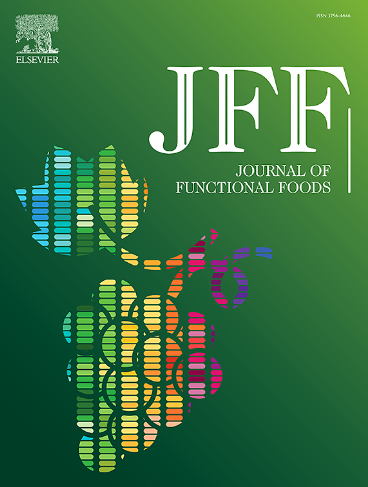猪骨胶原衍生肽通过抑制RAW264.7细胞钙敏感受体抑制低级别慢性炎症
IF 3.8
2区 农林科学
Q2 FOOD SCIENCE & TECHNOLOGY
引用次数: 0
摘要
本研究在RAW264.7细胞中研究了猪骨胶原肽(PBPs)的抗炎能力。在模拟消化过程中,PBPs对RAW264.7细胞中肿瘤坏死因子-α (TNF-α)和一氧化氮(NO)的分泌有显著抑制作用。与脂多糖(LPS)诱导组相比,PBPs (10 μg/mL)显著降低Ca2+荧光强度。根据与CaSR的结合特性选择抗炎肽序列,其中GPTGF (Gly-Pro-Thr-Gly-Phe)具有显著的炎症调节作用,并在cco -2单层细胞中进行转运。与cinacalcet治疗组相比,GPTGF先抑制CaSR,然后抑制TNF-α、白细胞介素-6 (IL-6) mRNA的表达。一般来说,PBPs通过抑制CaSR来抑制RAW264.7细胞的炎症反应,这是发挥抗炎作用的主要途径。本文章由计算机程序翻译,如有差异,请以英文原文为准。

The porcine bone collagen-derived peptides suppressed the low-grade chronic inflammation via restraining calcium-sensing receptor in RAW264.7 cells
In the current study, the anti-inflammatory capacity of porcine bone collagen peptides (PBPs) was investigated in RAW264.7 cells. During the simulated digestion process, the PBPs showed a significant inhibiting effect on the secretion of tumor necrosis factor-α (TNF-α), and nitric oxide (NO) in RAW264.7 cells. The PBPs (10 μg/mL) significantly decreased the Ca2+ fluorescence intensity compared with the lipopolysaccharide (LPS) induced group. Furthermore, the anti-inflammatory peptide sequences were selected according to the binding property with the CaSR, among which the GPTGF (Gly-Pro-Thr-Gly-Phe) showed a significant inflammatory regulating effect and also checked to be transported in Caco-2 monolayer cells. Compared with the Cinacalcet-treated group, the GPTGF posed to suppress the CaSR and then inhibited the mRNA expressions of TNF-α, and interleukin-6 (IL-6). Generally, the PBPs were demonstrated to suppress the inflammatory response in RAW264.7 cells by inhibiting CaSR as the major pathway to exert the anti-inflammatory effect.
求助全文
通过发布文献求助,成功后即可免费获取论文全文。
去求助
来源期刊

Journal of Functional Foods
FOOD SCIENCE & TECHNOLOGY-
CiteScore
9.60
自引率
1.80%
发文量
428
审稿时长
76 days
期刊介绍:
Journal of Functional Foods continues with the same aims and scope, editorial team, submission system and rigorous peer review. We give authors the possibility to publish their top-quality papers in a well-established leading journal in the food and nutrition fields. The Journal will keep its rigorous criteria to screen high impact research addressing relevant scientific topics and performed by sound methodologies.
The Journal of Functional Foods aims to bring together the results of fundamental and applied research into healthy foods and biologically active food ingredients.
The Journal is centered in the specific area at the boundaries among food technology, nutrition and health welcoming papers having a good interdisciplinary approach. The Journal will cover the fields of plant bioactives; dietary fibre, probiotics; functional lipids; bioactive peptides; vitamins, minerals and botanicals and other dietary supplements. Nutritional and technological aspects related to the development of functional foods and beverages are of core interest to the journal. Experimental works dealing with food digestion, bioavailability of food bioactives and on the mechanisms by which foods and their components are able to modulate physiological parameters connected with disease prevention are of particular interest as well as those dealing with personalized nutrition and nutritional needs in pathological subjects.
 求助内容:
求助内容: 应助结果提醒方式:
应助结果提醒方式:


